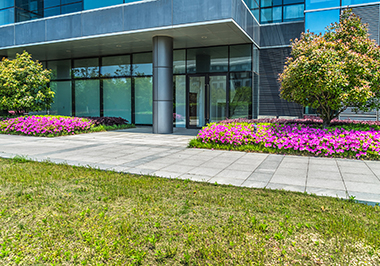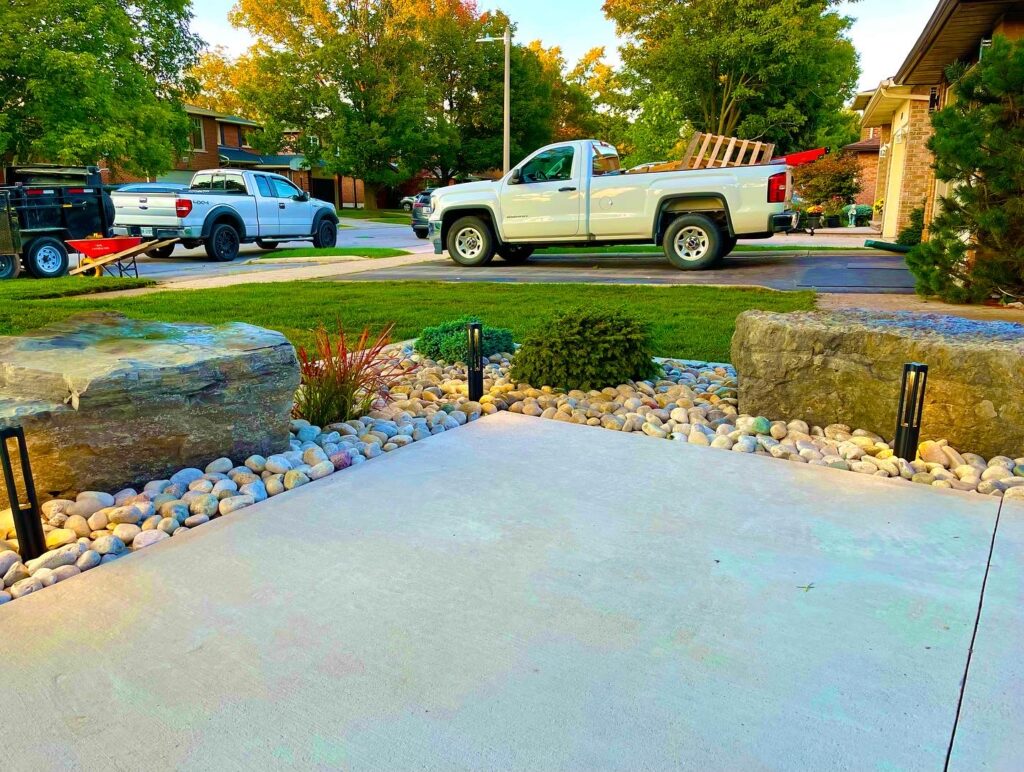Five benefits of hiring expert landscaping services for your home
Wiki Article
Recognizing the Comprehensive Range of Functions in Professional Landscaping Services
The considerable scope of professional landscaping services encompasses a range of essential components. It includes landscape design principles, plant option, and hardscaping functions. Additionally, it addresses watering systems and upkeep methods. Each facet plays a critical role in creating practical and visually pleasing outside spaces. Comprehending how these elements work with each other can disclose much concerning the art and science of landscaping. Nevertheless, the journey right into this elaborate area is simply beginning.
Landscape Layout Principles
Efficient landscape style concepts are crucial for creating unified outdoor rooms that enhance both visual charm and functionality. These principles assist the plan of aspects within the landscape, ensuring a natural visual experience. Key parts include balance, which disperses visual weight evenly; percentage, which relates the size of various components to every other and the space; and unity, which creates a sense of integrity through consistent themes and materials.
Moreover, focus routes focus to focal points, while rhythm establishes movement through rep of style features. The effective use line can produce paths and lead the eye through the landscape. On top of that, comprehending the website's topography, environment, and existing features is vital for combination with the surrounding setting. By sticking to these fundamental principles, landscape designers can craft rooms that not only look attractive yet also offer their designated purpose, improving the overall experience for individuals.
Plant Option and Installment
In the domain of specialist landscape design, plant selection and installation play a crucial role in accomplishing a growing garden - landscaping. Highlighting native plant advantages, seasonal factors to consider, and the details dirt and sunshine demands of each species guarantees a lasting and cosmetically pleasing landscape. Cautious preparation in these locations not only enhances biodiversity however also advertises lasting eco-friendly wellnessIndigenous Plant Benefits
Why should homeowners consider native plants for their landscape design jobs? Indigenous plants offer various advantages that boost both appearances and ecological sustainability. They are well-adapted to local environments, calling for much less water and maintenance compared to non-native varieties. This resilience decreases the requirement for chemical fertilizers and chemicals, promoting a healthier ecological community. In addition, native plants supply environment and food for regional wild animals, including pollinators, which can boost biodiversity in domestic locations. Their experience with neighborhood dirt and climate condition also leads to much better growth rates and durability. By selecting native plants, homeowners not only create aesthetically enticing landscapes however likewise add to environmental conservation, making a positive influence on their regional atmosphere. Consequently, indigenous plants stand for a clever choice for landscaping tasks.Seasonal Plant Considerations
House owners who have actually accepted indigenous plants in their landscaping can additionally boost their outdoor spaces by thinking about seasonal plant options. By incorporating plants that flourish in details seasons, they can develop dynamic and aesthetically appealing landscapes throughout the year. Springtime might introduce lively blossoms like tulips and daffodils, while summer season can showcase lush foliage and vivid perennials. Fall presents a scheme of cozy tones with asters and goldenrods, while winter season can be highlighted with evergreens and decorative lawns for appearance. Expert landscaping companies usually advise picking plants that not just enhance existing native varieties but also provide year-round interest and support local wildlife. This thoughtful method to seasonal plant choice assures a continuously progressing and sustainable yard atmosphere.Soil and Sunlight Demands
Successful landscape design rests on recognizing the details dirt and sunlight needs of plants. Various types grow under differing conditions, requiring a mindful analysis of both factors throughout the selection procedure (landscaping). Dirt kinds, such as sandy, clay, or loamy, impact water drainage, vitamins and mineral schedule, and origin development. In addition, pH degrees can affect plant wellness, requiring soil screening to establish suitability. Sunshine demands differ significantly; some plants thrive completely sunlight, while others choose partial or full color. An expert landscaper considers these components to assure peak development and aesthetic charm. By lining up plant selections with the setting's details attributes, landscapes can achieve sustainability, strength, and visual consistency, inevitably causing successful plant facility and long-term upkeepHardscaping Functions and Construction
While landscaping commonly stimulates pictures of rich greenery and vibrant blossoms, hardscaping attributes play a vital role in specifying exterior spaces. These components, which include patio areas, walkways, maintaining wall surfaces, and ornamental stonework, supply framework and performance to lawns and yards. Hardscaping makes use of materials such as concrete, stone, timber, and block, enabling diverse designs that enhance the all-natural landscape.The building and construction of hardscaping features needs cautious preparation and implementation to ensure resilience and aesthetic charm. Professionals assess site conditions, drain, and spatial connections to produce cohesive outdoor settings. Proper setup methods are critical, as they prevent issues like erosion and changing with time.
Including hardscaping not just boosts the aesthetic rate of interest of a building but additionally promotes exterior tasks, making it an essential element of complete landscape design services. Eventually, thoughtful hardscaping adds to both the performance and elegance of exterior rooms.
Watering Solutions and Water Administration
Reliable irrigation systems and water administration are vital parts of specialist landscaping, as they guarantee that plants receive the necessary hydration for optimal development. These systems can vary from simple drip watering configurations to sophisticated computerized automatic sprinkler, made to fulfill the certain requirements of varied landscapes. Correct water administration not only optimizes water usage, decreasing waste, but also enhances plant health and decreases disease dangers.Landscape design experts evaluate various variables, including dirt type, plant varieties, and regional environment, to establish tailored watering services. In addition, incorporating rain harvesting techniques can additionally enhance sustainability and performance (Read More). Routine upkeep of irrigation systems is necessary to preserve performance and stop leakages, which can bring about water loss and enhanced expenses. Eventually, a properly designed watering system plays a crucial role in maintaining the visual allure of outdoor spaces while promoting ecological stewardship within professional landscaping practices
Yard Treatment and Upkeep Strategies
Lawn treatment and upkeep techniques are basic for achieving a lush, healthy and balanced yard that enhances the overall landscape. These methods incorporate numerous methods focused on promoting optimal development and aesthetic allure. Normal mowing is vital, as it urges thick, even development while stopping weeds from establishing. Furthermore, proper fertilizing provides essential nutrients, with applications customized to the certain yard kind and soil conditions.Watering techniques need to concentrate on deep, seldom watering to motivate origin growth, while oygenation enhances soil framework and promotes nutrient absorption. Pest and illness administration is also critical; determining issues early enables efficient therapies that lessen damage.
Overseeding can rejuvenate thin or broken yards, improving density and shade. By executing these targeted grass care techniques, landscaping professionals can guarantee that yards stay healthy and balanced and vibrant throughout the seasons, considerably adding to the total charm of the property
Seasonal Landscape Treatment and Upkeep
As the seasons modification, appropriate landscape care becomes essential for preserving the health and appeal of exterior rooms. Each season presents one-of-a-kind obstacles and demands. In springtime, landscape professionals focus on trimming, growing, and feeding to encourage growth. Summertime needs normal watering, weed control, and insect administration to protect newly developed plants.Autumn needs the preparation of yards for winter season, consisting of mulching, fallen leave elimination, and the planting of light bulbs for the following springtime. In addition, winter care involves securing vulnerable plants from frost and guaranteeing that hardscapes are secure and functional.
Throughout the year, seasonal landscape upkeep guarantees that outdoor areas remain aesthetically attractive and healthy and balanced. Professional services can offer tailored upkeep plans that adjust to the details demands of each season, enabling homeowner to appreciate vivid landscapes year-round. On the whole, seasonal care is a vital aspect of expert landscaping that advertises longevity and visual worth.
Lasting Landscape Design Practices
An expanding variety of homeowner are welcoming lasting landscape design techniques to develop ecologically friendly exterior rooms. These techniques focus on conserving sources, improving biodiversity, and decreasing ecological effect. Indigenous plants are typically picked for their low water requirements and compatibility with neighborhood ecological communities, lowering the requirement for chemical plant foods and chemicals. Rain gardens and absorptive paving are utilized to take care of stormwater overflow, promoting groundwater recharge and lowering disintegration.Furthermore, lasting landscape design integrates organic horticulture methods that focus on soil health and promote all-natural pest control. Effective watering systems, such as drip watering and rainwater harvesting, help optimize water use. In addition, landscape developers progressively support for the use of recycled materials, such as reclaimed timber and rocks, to minimize waste. By taking on these sustainable practices, homeowner not just add to environmental conservation but also develop aesthetically pleasing environments that can love very little maintenance.
Frequently Asked Concerns
The length of time Does a Landscape Design Project Normally Require To Total?
Commonly, a landscape design task can take anywhere from a couple of days to several weeks to finish, relying on the project's intricacy, layout, and size demands. Read More. Aspects such as climate and source check my source accessibility also affect timelinesWhat Factors Impact the Price of Landscaping Services?
Numerous aspects influence landscape design service expenses, consisting of task dimension, design complexity, material high quality, labor expenditures, geographic place, and seasonal demand. Each component contributes distinctively to the total financial demands of a landscaping job.Are Landscaping Services Available Year-Round?
Landscape design services are typically readily available year-round, although accessibility might differ based on region, seasonal weather, and certain solution offerings. Some services may be limited during severe weather or off-peak seasons.Do Landscaping Business Deal Warranties on Their Work?

Can I Layout My Landscape Without Expert Aid?
Yes, individuals can design their landscapes without specialist help. However, they might lack know-how in plant selection, format, and ecological factors to consider, possibly bring about much less efficient designs that might call for pricey adjustments later.
Report this wiki page